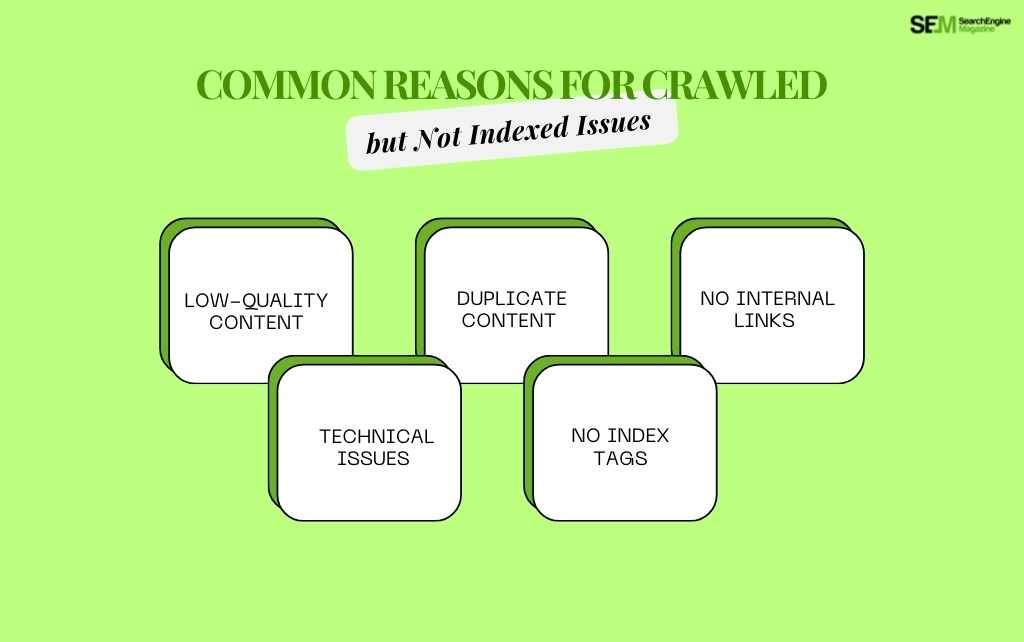How To Know If Someone Blocked You On iMessage? 5 Secret Hacks!
Apr 16, 2025

Apr 16, 2025

Apr 16, 2025

Apr 15, 2025

Apr 11, 2025

Apr 11, 2025

Apr 11, 2025

Apr 08, 2025

Mar 29, 2025
Sorry, but nothing matched your search "". Please try again with some different keywords.


If you have a website, it must be found easily by visitors. Problems arise when a search engine crawls but does not index a website. You might encounter some pages with the tag “crawled but not indexed.”
That means search engines have discovered your pages but haven’t indexed them. In this article, we will look at the simplest possible solution to such an issue on your site: “crawled but not indexed.”

Before knowing how to handle crawled but not indexed, you must understand what crawled but not indexed. Crawled but not indexed means you are referring to the process where a search engine scans your content and retrieves the data while visiting your website.
However, crawls do not ensure that the page will appear in the results of a search. If a page is “crawled but not indexed,” the search engine encounters it but chooses not to add it to its index.

Indexing is something your website will need to become visible. This means that if pages on the website aren’t indexed, they won’t appear in search results, and potential visitors will be unable to find them – potentially lowering traffic and other engagement or sales opportunities.
So, knowing how to fix crawled but not indexed issues is important for the success of your website.

To help solve this problem you need to know why in the first place. Here are some common reasons why your pages might be crawled but not indexed:
If you are providing little value, if the content is very there is not much information, search engines might just decide not to index it.
The same content on multiple pages might make search engines skip indexing to avoid redundancy.
Search engines could find it hard to index If you haven’t linked your page from any other part of your site.
Slow loading time, server errors, and bad configurations can hinder the website’s indexing ability.
Sometimes, webmasters inadvertently put no index tags on their pages and specify to the search engines that they do not want those pages crawled and indexed.

Now that we know why crawled but not indexed issues occur, let’s go ahead and see how we can solve them step by step.
The first knowing-how-to-fix crawled but not indexed issues is checking out your content.
Duplicate content on a site is downright confusing to search engines. Here’s how to correct it:
Internal links are necessary to allow search engines to find and index your pages. Here is how to do just that:
Sometimes, you will have technical issues that might fail to index. Here is how to troubleshoot:
Meta tags and your robots.txt file can impact how well your site can be indexed.
A sitemap helps search engines navigate through your pages. If you have made changes, resubmitting your sitemap may help in the following ways:
Now that you’ve made all the changes, just be patient. It will take a while before search engines rediscover your site. However, you can also request a re-crawl:
Keep track of your progress as you work to fix crawled but not indexed issues. Here is how to do it:
Here are a few additional troubleshooting tips for crawled but not indexed issues.
Search engine algorithms change daily. Keep in touch with the latest SEO techniques so that your site is always optimized.
Most people go to the web using their smartphones, so ensure your website is mobile-friendly as well because search engines rank mobile-friendly websites.
Have your content shared on other social media sites for increased traffic and, incoming links back to your website.
Respond to comments and keep interacting with the audience through community building surrounding your content.
Understanding how to fix crawled but not indexed problems is crucial in improving website visibility. Good quality content, removal of duplication of content, interlinking the internal pages, and a few technical problems will be done so that a greater number of pages get indexed by search engines.
Note that you also have the control of knowing how things are moving along using platforms such as Google Search Console, after which patience is all, you need because eventually, the crawl engine might take another trip around your site.
For sure, these tips will be all you need to get you started in managing crawled but not indexed issues and you’ll better your website’s performance.
Nabamita Sinha loves to write about lifestyle and pop-culture. In her free time, she loves to watch movies and TV series and experiment with food. Her favorite niche topics are fashion, lifestyle, travel, and gossip content. Her style of writing is creative and quirky.
View all Posts
How To Know If Someone Blocked You On iMessag...
Apr 16, 2025
7 Website Design Mistakes That Are Hurting Yo...
Apr 16, 2025
Programmable Dynamic SEO for Location-Based P...
Apr 15, 2025
Google Boba Game: How To Play This Fun Game B...
Apr 11, 2025
Which Is The Best Video Search Engine Of 2025...
Apr 11, 2025

